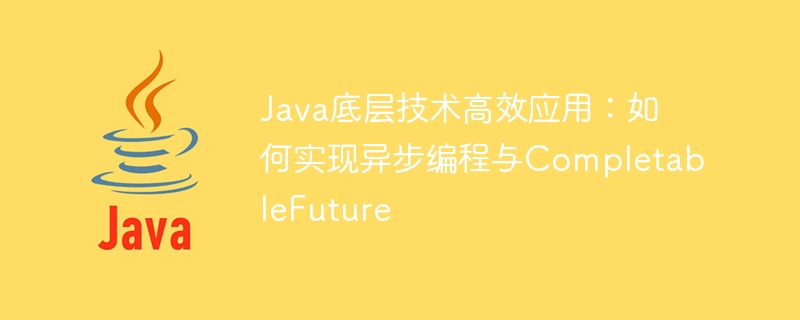Home >Java >javaTutorial >Efficient application of Java underlying technology: How to implement asynchronous programming and CompletableFuture
Efficient application of Java underlying technology: How to implement asynchronous programming and CompletableFuture
- WBOYWBOYWBOYWBOYWBOYWBOYWBOYWBOYWBOYWBOYWBOYWBOYWBOriginal
- 2023-11-08 12:16:541337browse

Efficient application of Java underlying technology: How to implement asynchronous programming and CompletableFuture
Introduction:
In modern software development, asynchronous programming has become an important way to improve system performance and One of the important technologies for user experience. As a widely used programming language, Java provides a variety of mechanisms to implement asynchronous programming. Among them, CompletableFuture is a powerful and flexible asynchronous programming tool that can simplify code and improve efficiency. This article will introduce what asynchronous programming is and how to use CompletableFuture to achieve efficient asynchronous programming. And illustrate it with specific code examples.
1. What is asynchronous programming?
Asynchronous programming is a programming model that allows a program to perform one operation while performing other operations. In traditional synchronous programming, when an operation occurs, the program waits for the operation to complete before continuing to the next step. In asynchronous programming, the program can continue to perform other operations without waiting for the current operation to complete.
Asynchronous programming can improve the concurrency performance of the system and enable the system to better cope with high concurrency scenarios. In actual development, common asynchronous operations include network requests, file reading and writing, database queries, etc. By making these operations asynchronous, the system can utilize resources more efficiently and improve system response speed and throughput.
2. How to implement asynchronous programming in Java
Java provides a variety of ways to implement asynchronous programming, such as multi-threading, callback functions, Future and CompletableFuture, etc. This article will focus on CompletableFuture, because it is a very powerful asynchronous programming tool added in Java 8.
CompletableFuture is a special implementation class in Java that can handle asynchronous tasks very conveniently. In CompletableFuture, you can use chain calls to combine multiple asynchronous operations to form an elegant and efficient asynchronous programming process.
The following is an example of asynchronous programming using CompletableFuture:
CompletableFuture<String> future = CompletableFuture.supplyAsync(() -> {
// 异步执行任务,返回结果
return "Hello, CompletableFuture!";
}).thenApplyAsync(result -> {
// 对任务结果进行处理,返回新的结果
return result.toUpperCase();
}).whenComplete((result, exception) -> {
// 完成处理操作
if (exception != null) {
// 处理异常情况
System.out.println("Exception occurred: " + exception.getMessage());
} else {
// 处理正常情况
System.out.println(result);
}
});In the above example, a new asynchronous task is created using the CompletableFuture.supplyAsync method. The task results can be processed through the thenApplyAsync method, and then a new CompletableFuture object is returned. Finally, the execution results of the asynchronous task are processed through the whenComplete method.
3. Application of advanced features of CompletableFuture
In actual development, CompletableFuture also provides some other advanced features, such as exception handling, timeout control, multi-task merging, asynchronous task waiting, etc. . The following uses specific examples to demonstrate the application of these features.
Exception handling:
CompletableFuture.supplyAsync(() -> {
throw new RuntimeException("Oops, exception occurred!");
}).exceptionally(ex -> {
// 处理异常情况
System.out.println("Exception occurred: " + ex.getMessage());
return "default value";
});The exceptionally method can handle exceptions that occur in asynchronous tasks and return a default value or other remedies.
Timeout control:
CompletableFuture<String> future = CompletableFuture.supplyAsync(() -> {
// 异步执行任务
return "Hello, CompletableFuture!";
}).orTimeout(1, TimeUnit.SECONDS);You can control the timeout of asynchronous tasks through the orTimeout method. If the task fails to complete within the specified time, it will throw TimeoutExceptionException.
Multi-task merging:
CompletableFuture<String> future1 = CompletableFuture.supplyAsync(() -> "Hello");
CompletableFuture<String> future2 = CompletableFuture.supplyAsync(() -> "CompletableFuture!");
CompletableFuture<String> combinedFuture = future1.thenCombine(future2, (result1, result2) -> {
// 合并任务结果
return result1 + ", " + result2;
});The results of multiple asynchronous tasks can be combined through the thenCombine method to form a new CompletableFuture object, Then process the merged results.
Asynchronous task waiting:
CompletableFuture<String> future1 = CompletableFuture.supplyAsync(() -> {
try {
Thread.sleep(1000);
} catch (InterruptedException e) {
e.printStackTrace();
}
return "Hello";
});
CompletableFuture<String> future2 = CompletableFuture.supplyAsync(() -> "CompletableFuture!");
CompletableFuture<Void> allFutures = CompletableFuture.allOf(future1, future2);
try {
// 等待所有异步任务执行完毕
allFutures.get();
} catch (InterruptedException | ExecutionException e) {
e.printStackTrace();
}The allOf method can make the current thread wait for all asynchronous tasks to be executed before continuing to execute the following code.
Conclusion:
This article introduces the concept of Java asynchronous programming and the use of CompletableFuture. By using CompletableFuture, we can simplify the complexity of asynchronous programming and improve the performance and response speed of the system. At the same time, CompletableFuture also provides some advanced features, such as exception handling, timeout control, multi-task merging, etc., which can be flexibly applied according to specific needs.
In actual development, a large number of IO operations can be optimized through asynchronous programming to improve system throughput. By rationally using asynchronous programming technology, we can better cope with high-concurrency scenarios and improve the user experience of the system.
If you have not used CompletableFuture, then I encourage you to try it, I believe you will be attracted by its powerful functions. I hope this article can provide some help for you to understand and use CompletableFuture. Let's work together to create more efficient Java applications!
The above is the detailed content of Efficient application of Java underlying technology: How to implement asynchronous programming and CompletableFuture. For more information, please follow other related articles on the PHP Chinese website!
Related articles
See more- Detailed explanation of node Async/Await asynchronous programming implementation
- How to use java random number random
- How to retain two decimal places in java
- Java backend development: API asynchronous programming using Java CompletableFuture
- Java Error: Java8 CompletableFuture Error, How to Handle and Avoid

